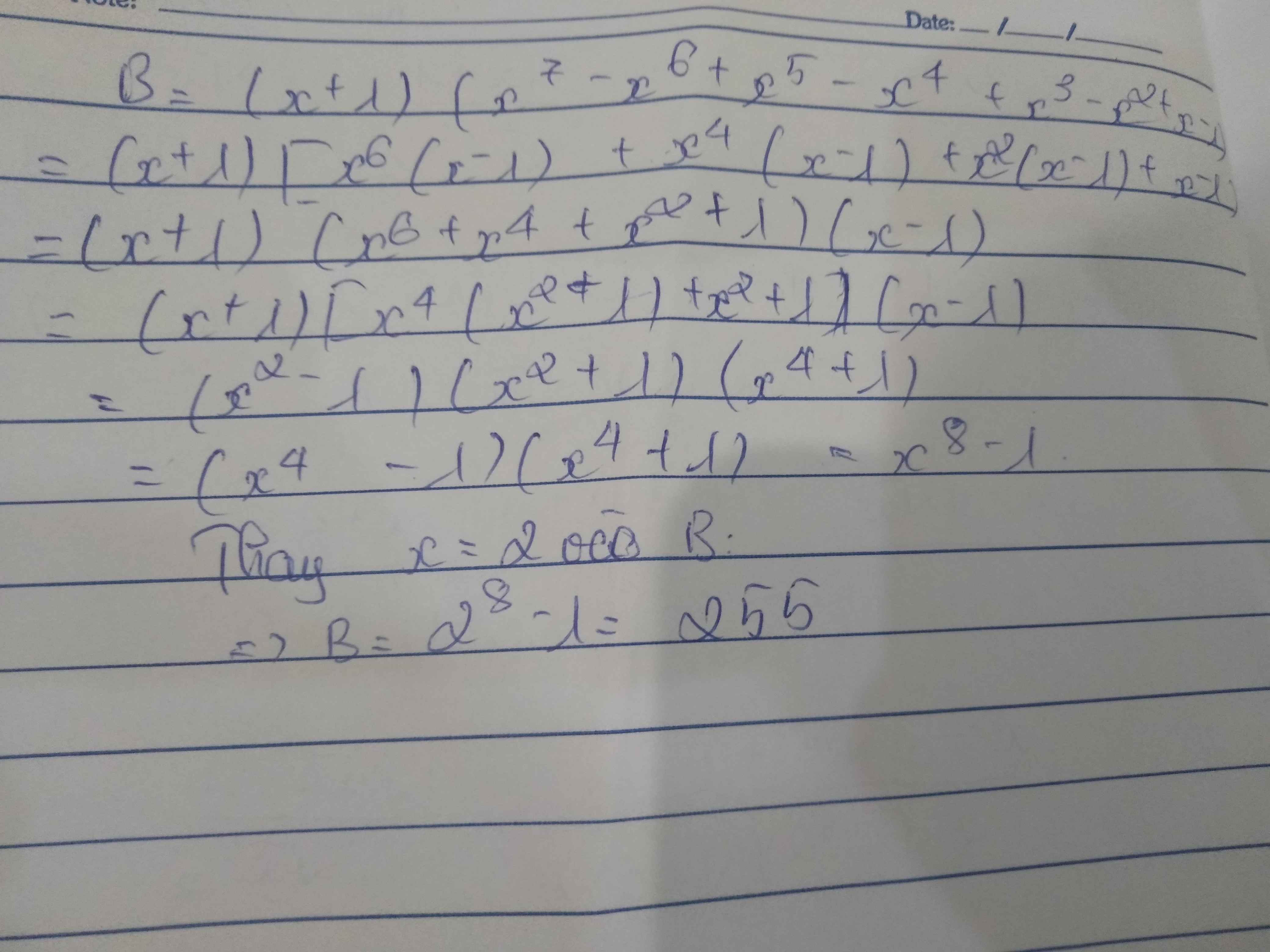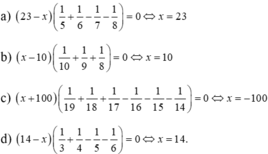
Hãy nhập câu hỏi của bạn vào đây, nếu là tài khoản VIP, bạn sẽ được ưu tiên trả lời.


Ta có: x=2
nên x-1=1
Ta có: \(B=\left(x+1\right)\left(x^7-x^6+x^5-x^4+x^3-x^2+x-1\right)\)
\(=\left(x+1\right)\left[x^6\left(x-1\right)+x^4\left(x-1\right)+x^2\left(x-1\right)+\left(x-1\right)\right]\)
\(=\left(x+1\right)\left(x^6+x^4+x^2+1\right)\)
\(=\left(x+1\right)\left(x+1\right)\left(x^4+1\right)\)
\(=\left(2^4+1\right)\left(2+1\right)^2=17\cdot9=153\)

2: \(=\dfrac{\left(x-y\right)\left(x+y\right)\left(x^2+y^2\right)}{-\left(x-y\right)\left(x^2+xy+y^2\right)}=\dfrac{-\left(x+y\right)\left(x^2+y^2\right)}{x^2+xy+y^2}\)

1.
a/ \(\Leftrightarrow\left(x+1\right)\left(x^2+3x+2\right)+\left(x-1\right)\left(x^2-3x+2\right)-12=0\)
\(\Leftrightarrow\left(x+1\right)\left(x^2+2\right)+3x\left(x+1\right)-3x\left(x-1\right)+\left(x-1\right)\left(x^2+2\right)-12=0\)
\(\Leftrightarrow2x\left(x^2+2\right)+6x^2-12=0\)
\(\Leftrightarrow x^3+3x^2+2x-6=0\)
\(\Leftrightarrow\left(x-1\right)\left(x^2+4x+6\right)=0\Rightarrow x=1\)
b/ Nhận thấy \(x=0\) ko phải nghiệm, chia 2 vế cho \(x^2\)
\(x^2+\frac{1}{x^2}+3\left(x+\frac{1}{x}\right)+4=0\)
Đặt \(x+\frac{1}{x}=t\Rightarrow x^2+\frac{1}{x^2}=t^2-2\)
\(t^2-2+3t+4=0\Rightarrow t^2+3t+2=0\Rightarrow\left[{}\begin{matrix}t=-1\\t=-2\end{matrix}\right.\)
\(\Rightarrow\left[{}\begin{matrix}x+\frac{1}{x}=-1\\x+\frac{1}{x}=-2\end{matrix}\right.\) \(\Rightarrow\left[{}\begin{matrix}x^2+x+1=0\left(vn\right)\\x^2+2x+1=0\end{matrix}\right.\) \(\Rightarrow x=-1\)
1c/
\(\Leftrightarrow x^5+x^4-2x^4-2x^3+5x^3+5x^2-2x^2-2x+x+1=0\)
\(\Leftrightarrow x^4\left(x+1\right)-2x^3\left(x+1\right)+5x^2\left(x+1\right)-2x\left(x+1\right)+x+1=0\)
\(\Leftrightarrow\left(x+1\right)\left(x^4-2x^3+5x^2-2x+1\right)=0\)
\(\Leftrightarrow\left[{}\begin{matrix}x=-1\\x^4-2x^3+5x^2-2x+1=0\left(1\right)\end{matrix}\right.\)
\(\left(1\right)\Leftrightarrow x^4-2x^3+x^2+x^2-2x+1+3x^2=0\)
\(\Leftrightarrow\left(x^2-x\right)^2+\left(x-1\right)^2+3x^2=0\)
\(\Leftrightarrow\left\{{}\begin{matrix}x^2-x=0\\x-1=0\\x=0\end{matrix}\right.\) \(\Rightarrow\) không tồn tại x thỏa mãn
Vậy pt có nghiệm duy nhất \(x=-1\)

a. $6x^2-11x=x(6x-11)$
b. $x^7+x^5+1=(x^7-x)+(x^5-x^2)+x+x^2+1$
$=x(x^6-1)+x^2(x^3-1)+(x^2+x+1)$
$=x(x^3-1)(x^3+1)+x^2(x^3-1)+(x^2+x+1)$
$=(x^3-1)(x^4+x+x^2)+(x^2+x+1)$
$=(x-1)(x^2+x+1)(x^4+x^2+x)+(x^2+x+1)$
$=(x^2+x+1)[(x-1)(x^4+x^2+x)+1]$
$=(x^2+x+1)(x^5-x^4+x^3-x+1)$
c.
$x^8+x^4+1=(x^4)^2+2.x^4+1-x^4$
$=(x^4+1)^2-(x^2)^2$
$=(x^4+1-x^2)(x^4+1+x^2)$
$=(x^4+1-x^2)(x^4+2x^2+1-x^2)$
$=(x^4-x^2+1)[(x^2+1)^2-x^2]$
$=(x^4-x^2+1)(x^2+1-x)(x^2+1+x)$
d.
$x^3-5x+8-4=x^3-5x+4$
$=x^3-x^2+x^2-x-(4x-4)$
$=x^2(x-1)+x(x-1)-4(x-1)=(x-1)(x^2+x-4)$
e.
$x^5+x^4+1=(x^5-x^2)+(x^4-x)+x^2+x+1$
$=x^2(x^3-1)+x(x^3-1)+x^2+x+1$
$=(x^3-1)(x^2+x)+(x^2+x+1)$
$=(x-1)(x^2+x+1)(x^2+x)+(x^2+x+1)$
$=(x^2+x+1)[(x-1)(x^2+x)+1]$
$=(x^2+x+1)(x^3-x+1)$

a,
\(A=4(x-2)(x+1)+(2x-4)^2+(x+1)^2\\=[2(x-2)]^2+2\cdot2(x-2)(x+1)+(x+1)^2\\=[2(x-2)+(x+1)]^2\\=(2x-4+x+1)^2\\=(3x-3)^2\)
Thay $x=\dfrac12$ vào $A$, ta được:
\(A=\Bigg(3\cdot\dfrac12-3\Bigg)^2=\Bigg(\dfrac{-3}{2}\Bigg)^2=\dfrac94\)
Vậy $A=\dfrac94$ khi $x=\dfrac12$.
b,
\(B=x^9-x^7-x^6-x^5+x^4+x^3+x^2-1\\=(x^9-1)-(x^7-x^4)-(x^6-x^3)-(x^5-x^2)\\=[(x^3)^3-1]-x^4(x^3-1)-x^3(x^3-1)-x^2(x^3-1)\\=(x^3-1)(x^6+x^3+1)-x^4(x^3-1)-x^3(x^3-1)-x^2(x^3-1)\\=(x^3-1)(x^6+x^3+1-x^4-x^3-x^2)\\=(x^3-1)(x^6-x^4-x^2+1)\)
Thay $x=1$ vào $B$, ta được:
\(B=(1^3-1)(1^6-1^4-1^2+1)=0\)
Vậy $B=0$ khi $x=1$.
$Toru$

\(a,=\left(5x^3+10x\right)+\left(x^4-4\right)\\ =5x\left(x^2+2\right)+\left(x^2+2\right)\left(x^2-2\right)\\ =\left(x^2+2\right)\left(x^2+5x-2\right)\\ b,=\left(x+y\right)^3-3xy\left(x+y\right)+z^3-3xyz\\ =\left[\left(x+y\right)^3+z^3\right]-3xy\left(x+y+z\right)\\ =\left(x+y+z\right)\left[\left(x+y\right)^2-z\left(x+y\right)+z^2\right]-3xy\left(x+y+z\right)\\ =\left(x+y+z\right)\left(x^2+2xy+y-xz-yz+z^2-3xy\right)\\ =\left(x+y+z\right)\left(x^2+y^2+z^2-xy-yz-zx\right)\)
\(c,=\left(x^8+x^7+x^6\right)-\left(x^7+x^6+x^5\right)+\left(x^5+x^4+x^3\right)-\left(x^4+x^3+x^2\right)+\left(x^2+x+1\right)\\ =\left(x^2+x+1\right)\left(x^6-x^5+x^3-x^2+1\right)\\ d,=\left(x^7+x^6+x^5\right)-\left(x^6+x^5+x^4\right)+\left(x^4+x^3+x^2\right)-\left(x^3+x^2+x\right)+\left(x^2+x+1\right)\\ =\left(x^2+x+1\right)\left(x^5-x^4+x^2-x+1\right)\\ e,=\left(x^{10}+x^9+x^8\right)-\left(x^9+x^8+x^7\right)+\left(x^7+x^6+x^5\right)-\left(x^6+x^5+x^4\right)+\left(x^5+x^4+x^3\right)-\left(x^3+x^2+x\right)+\left(x^2+x+1\right)\\ =\left(x^2+x+1\right)\left(x^{10}-x^7+x^5-x^4+x^3-x+1\right)\)
a: =x^4+2x^2+5x^3+10x-2x^2-4
=(x^2+2)(x^2+5x-2)
b; =(x+y)^3+z^3-3xy(x+y)-3xyz
=(x+y+z)*(x^2+2xy+y^2-xz-yz+z^2)-3xy(x+y+z)
=(x+y+z)(x^2+y^2+z^2-xy-yz-xz)
c: =x^8+x^7+x^6-x^7-x^6-x^5+x^5+x^4+x^3-x^4-x^3-x^2+x^2+x+1
=(x^2+x+1)(x^6-x^5+x^3-x^2+1)




\(VT=\frac{x^{10}+x^5+1}{x^2+x+1}=\frac{\left(x^5+\frac{1}{2}\right)^2+\frac{3}{4}}{\left(x+\frac{1}{2}\right)^2+\frac{3}{4}}>0\)
Nguồn: diendantoanhoc.net
P/s. Bài này không làm theo kiểu xét từng khoảng được, có lẽ từ đầu người ra đề đã nghĩ theo hướng ở trên. Nếu xét từng khoảng thì khá khó ở khoảng \(\left(-1;0\right)\)